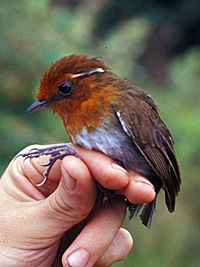Gnateater facts for kids
Quick facts for kids Gnateaters |
|
|---|---|
 |
|
| Chestnut-crowned Gnateater (Conopophaga castaneiceps) | |
| Scientific classification | |
| Kingdom: | |
| Phylum: | |
| Class: | |
| Order: | |
| Suborder: | |
| Family: |
Conopophagidae
|
Gnateaters are a fascinating group of small birds. They belong to a bird family called Conopophagidae. There are ten different kinds, or species, of gnateaters. These birds are found in the warm rainforests of South America and Central America.
Gnateaters are a type of passerine bird. This means they are part of a very large group of birds often called "perching birds." They are closely related to antbirds, and a bit less closely to antpittas and tapaculos. Because they live in remote forest areas, gnateaters are not as well-known or studied as some other birds. However, many birdwatchers enjoy trying to spot them! Gnateaters mainly eat insects, which they catch in the lower parts of the forest, known as the understory.
Contents
What are Gnateaters?
Gnateaters are small birds, usually about 10 to 16 centimeters (4 to 6 inches) long. They have short tails and strong legs. Their colors can be quite pretty, often with shades of brown, gray, and reddish-brown. Some species have bright patches of color, like orange or red, especially on their heads or bellies.
These birds get their name because they "eat gnats" and other small insects. They are very good at finding tiny bugs hidden in the leaves and on the ground.
Where Gnateaters Live
Gnateaters make their homes in the dense forests of South and Central America. They prefer the humid, tropical and subtropical forests. You can find them in the Amazon rainforest, as well as in cloud forests and other wet woodland areas.
They usually stay close to the forest floor, hopping around in the undergrowth. This makes them hard to spot, even for experienced birdwatchers! Their habitat provides plenty of insects for them to eat.
Gnateater Behavior and Diet
Gnateaters are mostly quiet and shy birds. They spend most of their time foraging for food on or near the ground. They often sit still on a low branch, watching for insects. When they spot one, they quickly dart out to catch it.
Their diet mainly consists of insects like ants, beetles, spiders, and other small invertebrates. They are very skilled at finding these tiny creatures among the leaves and branches.
Images for kids
See also
 In Spanish: Conopofágidos para niños
In Spanish: Conopofágidos para niños


